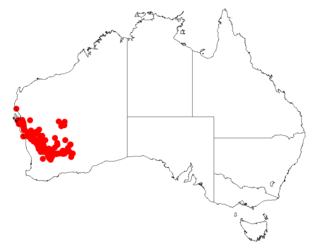
Acacia lirellata is a shrub belonging to the genus Acacia and the subgenus Juliflorae that is endemic to south western Australia.

Acacia multispicata, commonly known as spiked wattle, is a shrub belonging to the genus Acacia and the subgenus Juliflorae that is endemic to south western Australia.

Acacia neurophylla, also known as wodjil, is a shrub or tree belonging to the genus Acacia and the subgenus Juliflorae that is endemic to south western Australia.

Acacia oldfieldii is a shrub belonging to the genus Acacia and the subgenus Juliflorae that is endemic to western Australia.

Acacia rhodophloia, commonly known as minni ritchi or western red mulga, is a tree or shrub belonging to the genus Acacia and the subgenus Juliflorae that is endemic to a large area of arid central western Australia. The Indigenous group the Kurrama peoples know the plant as mantaru.

Acacia sessilispica is a shrub belonging to the genus Acacia and the subgenus Juliflorae native to Western Australia.

Acacia stereophylla is a tree or shrub belonging to the genus Acacia and the subgenus Juliflorae that is endemic to south western Australia.

Acacia profusa is a shrub of the genus Acacia and the subgenus Phyllodineae that is endemic to south western Australia.

Acacia sphacelata is a shrub of the genus Acacia and the subgenus Phyllodineae that is endemic to south western Australia.

Acacia ancistrophylla is a shrub of the genus Acacia and the subgenus Plurinerves that is native to several areas on southern Australia.

Acacia brachyphylla is a shrub of the genus Acacia and the subgenus Plurinerves that is endemic to a small area in south western Australia.

Acacia duriuscula is a shrub or tree of the genus Acacia and the subgenus Plurinerves that is endemic to an area of south western Australia.

Acacia enervia is a shrub or tree of the genus Acacia and the subgenus Plurinerves that is endemic to an area of south western Australia.

Acacia longispinea is a shrub or tree of the genus Acacia and the subgenus Plurinerves that is endemic to an area of south western Australia.

Acacia pharangites, commonly known as Wongan gully wattle, is a shrub of the genus Acacia and the subgenus Plurinerves that is endemic to the Wongan Hills of south western Australia and is listed as endangered according to the Environment Protection and Biodiversity Conservation Act 1999.

Acacia pinguiculosa is a shrub of the genus Acacia and the subgenus Plurinerves that is endemic to an area of south western Australia.

Acacia sulcata is a shrub of the genus Acacia and the subgenus Plurinerves that is endemic to an area of south western Australia.

Acacia triptycha is a shrub or tree of the genus Acacia and the subgenus Plurinerves that is endemic to an area of south western Australia.

Acacia williamsiana is a tree or shrub belonging to the genus Acacia and the subgenus Juliflorae that is native to eastern Australia.

Acacia subporosa, also commonly known as river wattle, bower wattle, narrow-leaf bower wattle and sticky bower wattle, is a tree or shrub of the genus Acacia and the subgenus Plurinerves that is endemic to an area of south eastern Australia. It is considered to be rare in Victoria




















